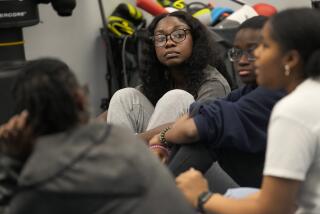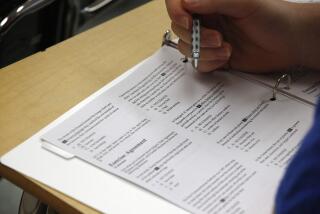How I Gamed the SAT
I wasn’t supposed to stop dead in the middle of grading the new essay portion of the SAT. In my stint as a scorer, I had learned the rules: Read quickly, read once, don’t stop to analyze, but assign a score from 1 (bottom) to 6 (top) based on my overall impression. So, as I cringed over a preposterous assertion in this 34th or 52nd essay on the topic, “Secrecy: Good or Bad?” I should have known my scoring on this one would be counted as “wrong.”
I kept forgetting another rule: In the SAT essay, it’s OK to write something that lacks a factual basis.The University of California had been on the verge of dropping the SAT as an admissions requirement when the College Board reconstituted the test, adding an 800-point writing segment. The persuasive essay counts for about 30% of that score, and a lot of overachievers who are more comfortable with Scantron than scribbling are very nervous.
To find out what the new SAT essay is like, I persuaded the College Board and Pearson Educational Measurement, which does the scoring, to train me as a reader. I attended a morning workshop that tried us out on a handful of essays. Then I took Pearson’s self-paced, online course and several tests. To qualify as a reader, I’d have to score a certain number of essays at or close to a predetermined grade.
What I learned is that, like anything else, the essay test can be gamed. (For that matter, the test to qualify as a reader can be gamed.) Readers are supposed to score essays based on whether the writing is organized, well reasoned and written with logical and writerly complexity. Readers are supposed to overlook minor errors in grammar and spelling. Varied sentences and vocabulary are good, and smooth transitions help. We’re supposed to overlook the kind of examples students use to back up their arguments — personal anecdote is as valid as a riff from Renaissance history. Nor does it matter if there’s any truth to the example used. So if kids tell you (and they do) that revealing secrets staves off insanity, just suspend all critical thinking and go with it.
I had been warned that as a journalist I would be too tough on the kids. I would forget to see past the occasionally awkward transitions or stumbles of grammar. On the contrary, I felt immensely sympathetic toward almost anyone who managed to string together semi-clear sentences. Imagine having 25 minutes to read a couple of contrasting quotes on a topic and comprehend the assignment, think of what position to take, come up with examples, and then figure out how to organize all this into lovely prose. I write persuasive essays for a living, and my editor can attest that I’ve never completed one in 25 minutes.
To qualify as a reader, I had to score three sets of 10 essays. On at least one of those sets I had to match the pre-scored grade exactly on half the essays, and on 90% I had to be within one point of the accepted score.
There’s a trick to this. The three bottom scores were easy to assign. A “1” was little more than a dribble of ungrammatical English, and a “2” was hardly more than that. A “3” was a well-meaning attempt to cobble three paragraphs together. The problem was in the 4-to-6 range. A “4” is a good piece — crisp, clear, organized. It seemed that the “complexity” and “layering” that the head folks looked for to get beyond that added up to little more than icing that any good editor would ax — extra examples, fancy words.
So I gave the bottom feeders the scores I thought they deserved, and scored the stronger pieces in the compromise range. If I thought it was at least a “4” but might be a “5,” I’d go for “5” because it might be a “6,” and at least I’d be “adjacent.” By scoring many of the essays by what was safely “adjacent,” rather than by what I thought they deserved, I passed all three qualifying sets.
There are other eccentricities: Students scored with multiple examples even if those added nothing to the argument. And though the Pearson folks will protest mightily that it’s not so, higher scores seemed to go to writers who made sure at least one or two of their anecdotes were not personal. Current events win out over revealing the secret of a suicidal friend.
Length doesn’t always mean a better score, but I would advise any kid: Write at least a page and a quarter. Nobody who got one of the top scores wrote one page or less. A few essays that struck me as clear, terse, logical and readable got strangely mediocre scores. More sadly, the test will reflect poorly on many a fine thinker and writer who contemplates deeply and composes through careful honing.
If I had to prepare my children for this test, I’d say: Prepackage some thinking. Get familiar with a couple of Greek myths or literary classics that would work for multiple themes. One of the very few essays to score a “6” — a well-earned one — used “Madame Bovary” to illustrate the harm secrets can do. But the writer could also have used Flaubert’s classic to discuss image versus substance, or ambition versus contentment or almost any of the nostrums test-makers use as essay prompts. (Remember, most of the scorers are former or current English teachers — suckers for literary stuff.)
More advice: Prepare a few highly burnished words that can be applied to almost any situation. A prepared sentence or two wouldn’t hurt. One essay struck me with its well-wrought line: “It may be the case, then, that secrecy has its own time and place in our vast world.” I was dazzled by the calm maturity of that sentence — until I realized it could well have been composed in advance. Ritual has its own time and place in our vast world, as does protest, passion, tomfoolery — even testing. No matter, I gave the kid credit for planning. With so little time to write — in pencil, no less! — no one can afford to spend time actually thinking.
The main thing to love about the test is that many parents will hound the schools into teaching more writing. Loathe to read the effusions of 130 teenagers, teachers have minimized writing assignments. After my experience with mere dozens of “secret” essays, I’m all sympathy. But it’s insane for everyone to talk about a rigorous curriculum when middle school and high school students — who should be well past life’s mucilage stage — are assigned “reports” that involve little more than pasting pictures on poster board. No one can pretend that the SAT will measure brilliantly idiosyncratic writing and thinking, or that it remotely resembles real academic work. Don’t worry about it. In the arcane matrix of scoring rubrics, students who fare extremely well on the multiple-choice part of the writing test can get a perfect or close-to-perfect score without hitting a “6” on the essay. With a little prep work and a few high-flown literary allusions in hand, any grade-grubber can do it.
But I’m still stopped dead wondering why better-kept secrets would have prevented the Iraq war. I guess it’s a secret.
More to Read
A cure for the common opinion
Get thought-provoking perspectives with our weekly newsletter.
You may occasionally receive promotional content from the Los Angeles Times.






